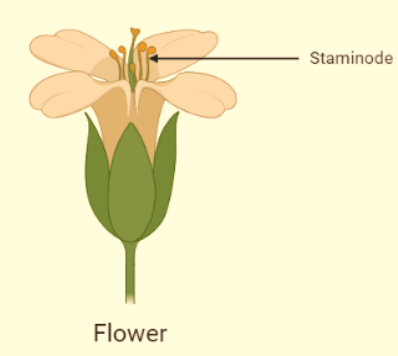
Answer
451.2k+ views
Hint: Staminode is present in the flower. In addition to it, staminodes are the sterile or abortive stamen present in flowers. Staminodes are the stamens, i.e., the male reproductive unit of flowering plants.
Complete answer: The term staminode means the sterile or abortive stamen often referred to as rudimentary. The stamens which do not produce pollen grain are called staminodes. Pollen grains can be considered as the male gametes produced by the male reproductive part of the flower that is the stamen. Staminodes are the same as stamen but are sterile in nature and do not take part in reproduction. They are inconspicuous and are usually found in the inner whorl of flowers, but in some flowers, they are so long that they protrude from the corolla. The stamens in Caesalpinioideae are mostly ten or also less than ten due to their reduction in staminodes. Cassia is also referred to as Chinese cinnamon which shows the presence of staminodes that is the infertile stamen. In Hibiscus, Arachis, and Iberis staminodes are not present. Staminodes are a characteristic feature of the Caesalpinioideae family and not of Papilionaceae, Malvaceae, and Cruciferae family. So, staminodes are present in Cassia which belongs to the Cesalpinoideae family.

Therefore, option C is the correct answer.
Note: In some flowers the staminodes are modified to produce nectar in flowers. Such a modified staminode is seen in Witch Hazel. One of the examples of staminode is the tree which is growing in South America known as the cannonball tree. Cassia or Chinese cinnamon is used as a spice and also for medicinal use.
Complete answer: The term staminode means the sterile or abortive stamen often referred to as rudimentary. The stamens which do not produce pollen grain are called staminodes. Pollen grains can be considered as the male gametes produced by the male reproductive part of the flower that is the stamen. Staminodes are the same as stamen but are sterile in nature and do not take part in reproduction. They are inconspicuous and are usually found in the inner whorl of flowers, but in some flowers, they are so long that they protrude from the corolla. The stamens in Caesalpinioideae are mostly ten or also less than ten due to their reduction in staminodes. Cassia is also referred to as Chinese cinnamon which shows the presence of staminodes that is the infertile stamen. In Hibiscus, Arachis, and Iberis staminodes are not present. Staminodes are a characteristic feature of the Caesalpinioideae family and not of Papilionaceae, Malvaceae, and Cruciferae family. So, staminodes are present in Cassia which belongs to the Cesalpinoideae family.

Therefore, option C is the correct answer.
Note: In some flowers the staminodes are modified to produce nectar in flowers. Such a modified staminode is seen in Witch Hazel. One of the examples of staminode is the tree which is growing in South America known as the cannonball tree. Cassia or Chinese cinnamon is used as a spice and also for medicinal use.
Recently Updated Pages
Identify the feminine gender noun from the given sentence class 10 english CBSE

Your club organized a blood donation camp in your city class 10 english CBSE

Choose the correct meaning of the idiomphrase from class 10 english CBSE

Identify the neuter gender noun from the given sentence class 10 english CBSE

Choose the word which best expresses the meaning of class 10 english CBSE

Choose the word which is closest to the opposite in class 10 english CBSE

Trending doubts
Which are the Top 10 Largest Countries of the World?

How do you graph the function fx 4x class 9 maths CBSE

Fill the blanks with the suitable prepositions 1 The class 9 english CBSE

Kaziranga National Park is famous for A Lion B Tiger class 10 social science CBSE

The Equation xxx + 2 is Satisfied when x is Equal to Class 10 Maths

Difference between Prokaryotic cell and Eukaryotic class 11 biology CBSE

Change the following sentences into negative and interrogative class 10 english CBSE

Give 10 examples for herbs , shrubs , climbers , creepers

Write a letter to the principal requesting him to grant class 10 english CBSE




